Common Mistakes in Managing Hypertension in Home Settings
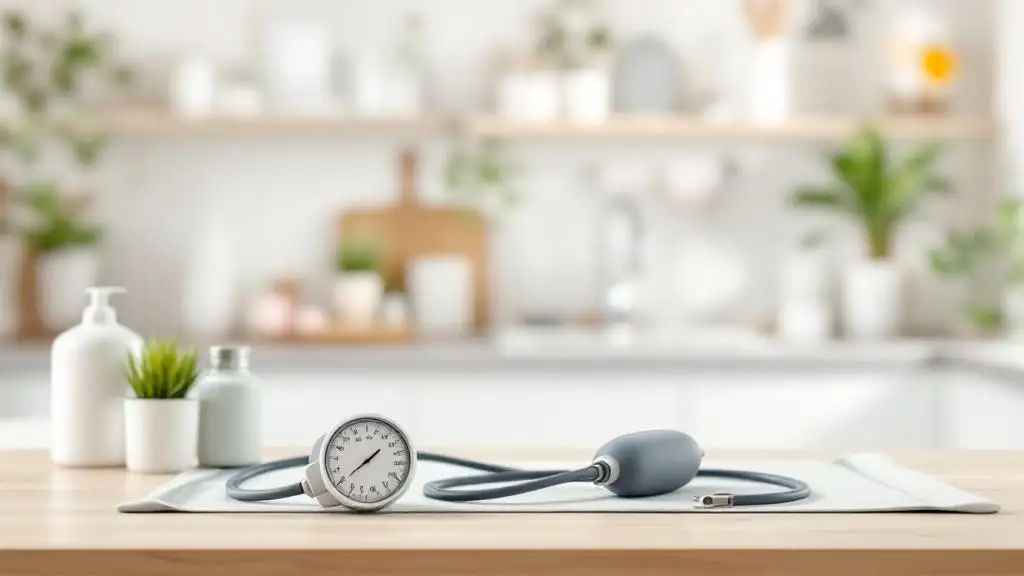
Understanding the Significance of Proper Home Hypertension Management
Managing hypertension effectively requires accurate blood pressure measurement, especially in home settings where routine monitoring can make a significant difference. However, common mistakes and procedural errors can compromise the reliability of readings, leading to misdiagnosis and inappropriate treatment. This article explores the typical pitfalls, their consequences, and best practices to ensure precise blood pressure monitoring, ultimately aiding better hypertension control.
The Critical Role of Accurate Blood Pressure Measurement in Hypertension Management
Why is it important to monitor blood pressure regularly at home?
Regular blood pressure monitoring at home plays a vital role in the proper management of hypertension. It helps identify phenomena like white-coat hypertension, where patients exhibit elevated BP readings only in clinical settings, and masked hypertension, which presents with apparently normal office BP but high readings at home. By capturing daily variations and providing a more complete picture of blood pressure patterns, home monitoring allows for more accurate diagnosis.
In addition, self-monitoring enables patients and healthcare providers to evaluate the effectiveness of antihypertensive treatments over time. This tracking can lead to timely medication adjustments and better control of blood pressure, significantly reducing the risk of organ damage, cardiovascular events, and stroke.
Studies show that blood pressure readings taken at home are often more accurate predictors of cardiovascular risk than single office measurements. They reflect the patient’s typical daily BP, free from the anxiety or stress of a clinical environment.
Moreover, engaging patients in their own care through regular monitoring improves motivation, adherence to medications, and lifestyle changes. When protocols are followed correctly—using validated devices and proper technique—the data collected is reliable, promoting better health outcomes.
In summary, home blood pressure monitoring is an essential component for diagnosing, treating, and controlling hypertension effectively. It supports a comprehensive approach that combines clinical and out-of-office measurements, ultimately contributing to the reduction of cardiovascular risks associated with high blood pressure.
Common Procedural Errors in Home Blood Pressure Measurement
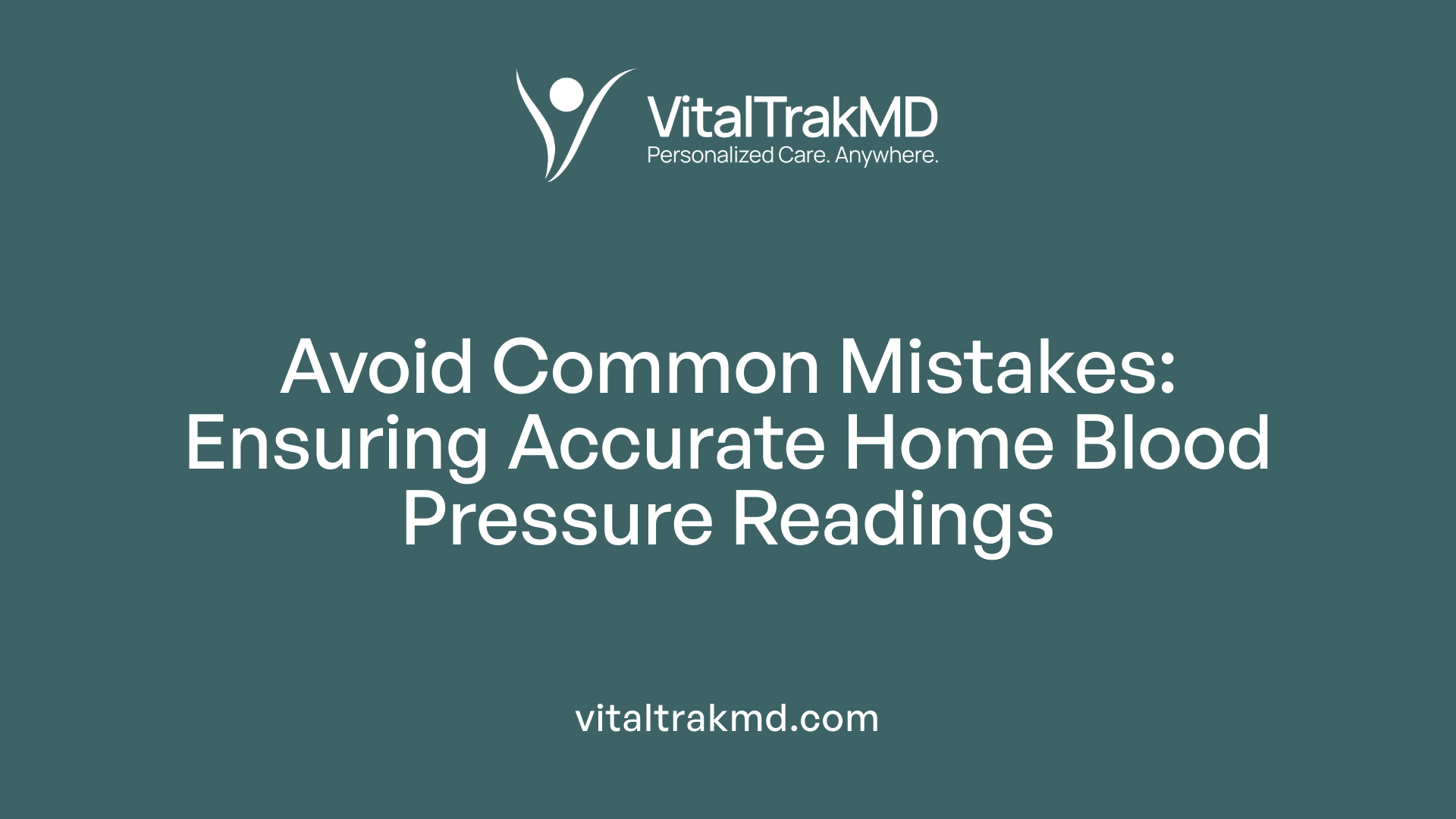
What errors and pitfalls should be avoided when measuring blood pressure at home?
Accurate blood pressure (BP) measurement at home is crucial for effective hypertension management. However, several common mistakes can compromise the reliability of readings. Firstly, using an improperly sized cuff is a frequent error. A cuff that is too small or too loose can cause readings to be falsely high by 2 to 10 points, while an oversized cuff might lead to underestimated values.
Proper cuff placement is essential. The cuff should be wrapped around a bare arm, with the bladder covering at least 80% of the arm's length and 40% of the circumference. It must be positioned over the brachial artery and secured snugly, allowing space for two fingers underneath. Wrapping the cuff over clothing can add up to 50 points to the measurement, so direct skin contact is always preferred.
Patient preparation plays a vital role. Patients should rest for at least five minutes before measurement, avoid caffeine, nicotine, exercise, and heavy meals for 30 minutes prior, and empty their bladder. These factors can temporarily increase BP readings by up to 15 points.
Proper positioning of the patient is equally important. The individual should sit with their back supported, feet flat on the floor, legs uncrossed, and the arm supported at heart level. Unsupported arms or crossed legs can inflate readings by 6 to 10 points or more.
During measurement, talking, answering questions, or engaging in active listening can increase the BP reading by about 10 points. Patients should remain silent and still during each measurement.
Taking multiple readings—typically two or three, spaced about one minute apart—is recommended to get an accurate assessment. It's beneficial to record readings at consistent times—morning and evening over several days—and share these with your healthcare provider.
Lastly, regular calibration of the device and adherence to validated protocols are vital to prevent systematic errors. Ensuring these practices can significantly improve measurement accuracy, leading to more appropriate diagnosis and management of hypertension.
Choosing and Using the Right Devices for Home Blood Pressure Monitoring
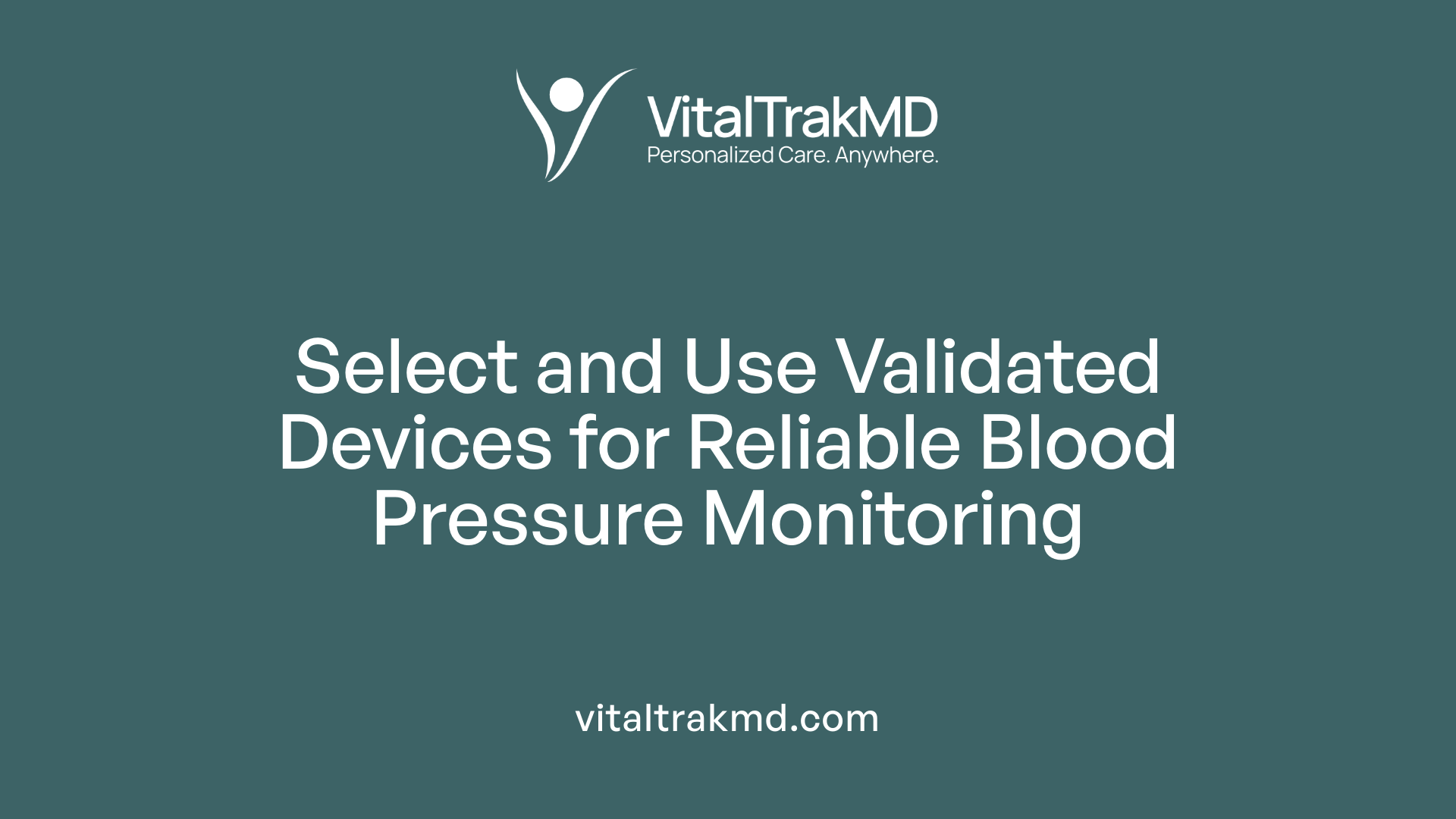
Validation and accuracy of automatic upper arm cuff devices
Using validated automatic upper arm cuff monitors is essential for obtaining reliable blood pressure readings at home. These devices are rigorously tested against clinical standards to ensure accuracy, which is crucial for making informed health decisions. The American Heart Association recommends selecting devices that have been validated through independent testing, often indicated by validation logos or certification. Proper calibration and maintenance of these monitors are necessary to sustain measurement precision over time.
Importance of cuff size and correct cuff placement
An appropriately sized cuff significantly impacts the accuracy of blood pressure measurements. The cuff's bladder should be about 80% of the arm's length and at least 40% of the arm's circumference. A cuff that is too small may lead to overestimated readings by 2-10 mm Hg, while a cuff that is too wide can cause underestimated blood pressure.
Proper cuff placement is equally vital. The cuff should be wrapped snugly around a bare upper arm, with the artery mark aligned over the brachial artery. It should be positioned at heart level, supported by the arm resting on a flat surface to prevent confounding errors. Ensuring the cuff is not over clothing—especially thick or tight garments—is necessary, as this can add up to 50 points to the readings.
Risks associated with unvalidated or improperly calibrated devices
Devices that are unvalidated or have not been calibrated correctly pose risks of erroneous readings. These inaccuracies can range from falsely high to falsely low blood pressure readings, leading to misdiagnoses or inappropriate medication adjustments. For example, unvalidated devices might not be sensitive enough to detect true blood pressure levels or may be affected by manufacturing defects.
Using uncalibrated devices can result in consistent measurement errors, undermining patient trust and complicating treatment. Regular verification of device accuracy in accordance with manufacturer instructions and periodic calibration checks are essential steps for safe home monitoring.
| Device Validation Status | Potential Error Range | Risk Description | Additional Notes |
|---|---|---|---|
| Validated (certified) | Minimal, within 3 mm Hg | Reliable for diagnosis and monitoring | Supported by health authorities like AHA |
| Unvalidated | Variable, often higher or lower | Increased risk of misclassification | Use only validated devices |
| Calibrated regularly | Maintains accuracy over time | Ensures consistent readings | Follow manufacturer calibration instructions |
Accurate home blood pressure monitoring depends heavily on the quality of the device and proper technique. Patients should select validated devices, ensure correct cuff size and placement, and maintain regular calibration to get reliable readings that accurately guide hypertension management.
Proper Technique: Positioning, Rest, and Timing
What are the proper techniques for home blood pressure measurement?
Ensuring accurate blood pressure readings at home begins with proper technique. Patients should sit quietly for at least five minutes in a supported, comfortable position, preferably with their back resting against a chair and feet flat on the floor, avoiding crossing legs. The patient's arm should be supported on a flat surface and positioned at heart level, not above or below, to prevent false readings.
Using a validated automatic upper arm cuff monitor is crucial. The cuff must fit snugly around the bare upper arm—covering about 80% of the arm's length and 40% of its circumference—without being too tight or loose. Proper placement over the brachial artery is essential for accuracy.
Patients should abstain from smoking, caffeine, alcohol, and vigorous physical activity for at least 30 minutes before measuring. To reduce variability, they should empty their bladder before the measurement.
Measurements should be taken twice at the same time each day, one minute apart, to establish a reliable reading. Initially, they should measure both arms to identify any significant differences.
Consistent adherence to this protocol over several days forms the foundation for reliable blood pressure monitoring. Regular training and guidance from healthcare providers can further enhance measurement accuracy, helping to better manage and diagnose hypertension.
Handling Inaccuracies and Ensuring Reliable Blood Pressure Readings
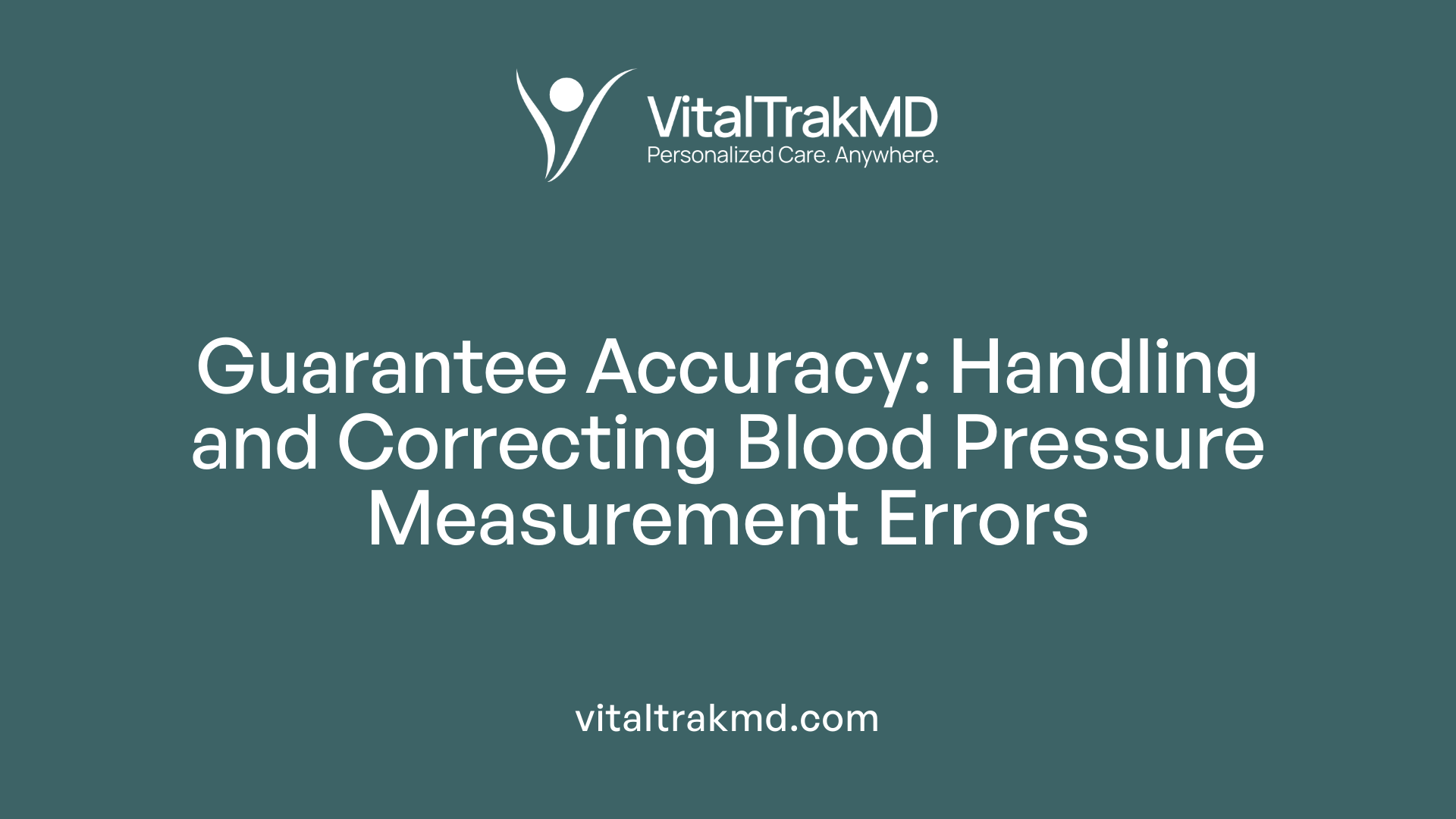
How can inaccuracies in blood pressure readings be avoided?
Ensuring accurate blood pressure (BP) measurements is essential for correct diagnosis and management of hypertension. One primary approach is to adhere strictly to standardized measurement techniques. Using validated, automated upper arm cuff devices that are properly calibrated helps minimize device-related errors.
Patient preparation plays a significant role. Patients should rest quietly for 5-10 minutes before measurement, avoid caffeine, nicotine, or heavy meals for at least 30 minutes, and ensure the bladder is empty to prevent artificially elevated readings. Proper positioning is crucial; the patient's back and arm should be supported, with the arm at heart level and uncrossed legs. The cuff must be placed on a bare, supported arm, with the cuff appropriately sized—its bladder should be 80% of the arm's length and at least 40% of the circumference.
Healthcare professionals must be well-trained in proper techniques. They should avoid talking, answering questions, or engaging in active listening during measurement, as talking can increase BP by about 10 points. Rapid cuff deflation and not waiting for multiple readings can also lead to errors. Consistent training and periodic retraining of staff in correct measurement procedures are vital.
Regular calibration of devices ensures ongoing accuracy. In cases where readings appear inconsistent or anomalous, rechecking measurements is recommended. Repeated measurements, separated by 1-2 minutes, and averaging multiple readings over several days provide a more accurate estimation.
Home blood pressure monitoring (HBPM) offers additional accuracy by capturing BP in the patient’s natural environment. Validated devices should be used, with instructions provided to ensure proper technique. Regularly sharing BP logs with healthcare providers enables better assessment of true blood pressure patterns.
In summary, avoiding inaccuracies requires a combination of validated equipment, proper patient preparation and positioning, trained practitioners, and consistent rechecking when discrepancies arise. Following these practices helps prevent misclassification of hypertension and guides appropriate treatment.
Guidelines and Strategies for Effective Home Blood Pressure Monitoring and Hypertension Control
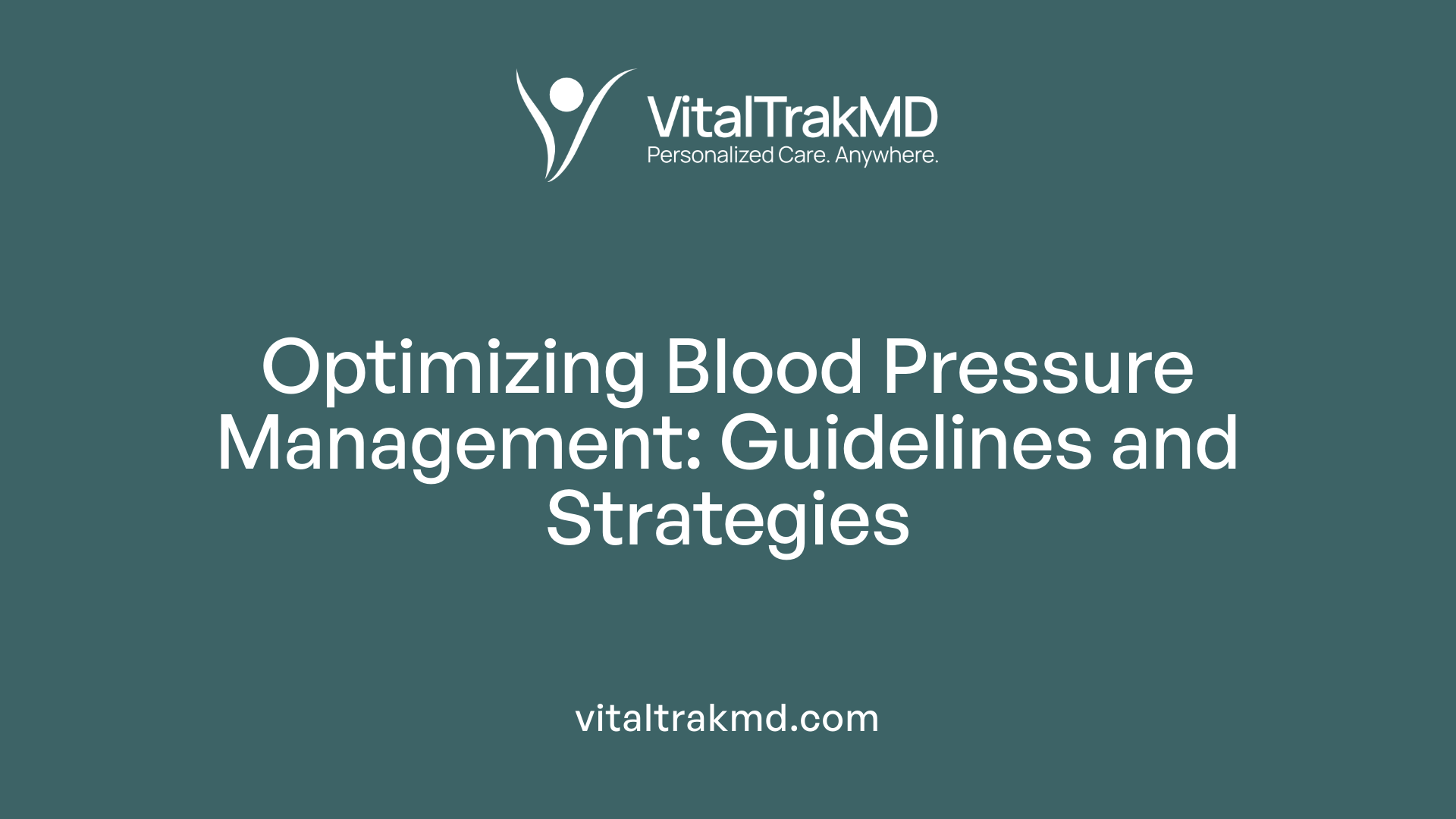
What guidelines and recommendations are available for effective home hypertension management?
Managing high blood pressure at home requires following established protocols to ensure accurate readings and effective control. Organizations like the American Heart Association (AHA) recommend using validated automated upper arm cuff devices and proper measurement techniques.
Patients should set a routine: measuring blood pressure twice daily, morning and evening, after resting quietly for at least five minutes. It is equally important to use the correct cuff size—generally one with a bladder width covering 80% of the arm's length and 40% of its circumference—to prevent errors.
Proper patient positioning enhances accuracy. The patient should sit with their back supported, feet flat on the floor or on a footstool, and legs uncrossed. The arm should be supported at heart level, free of supporting devices or clothing. Cuffs should be placed on a bare arm, wrapped snugly, with the artery mark aligned over the brachial artery.
To avoid false highs or lows, patients should avoid talking, moving, eating, caffeine, and nicotine at least 30 minutes before measurement. A full bladder can elevate readings by 10-15 points, so urination before measurement is advisable.
Taking multiple readings—usually two within a minute and averaging them—accounts for fluctuations, providing a more reliable assessment. Recording these results diligently and sharing them with healthcare providers supports accurate diagnosis and treatment adjustments.
Home blood pressure monitoring is instrumental in confirming hypertension, differentiating white-coat from masked hypertension, and monitoring medication effects. It aligns with current guidelines that underscore the importance of adherence to standardized measurement methods.
Overall, combining accurate self-monitoring with lifestyle modifications—such as reducing salt intake, engaging in regular physical activity, and adhering to prescribed medications—can substantially improve blood pressure control and reduce the risk of cardiovascular complications.
The Link Between Self-Care and Effective Hypertension Control

What factors are associated with successful hypertension self-care in home settings?
Effective self-care for hypertension at home depends on several interconnected factors. Foremost among these is medication adherence. Patients who take their prescribed antihypertensive drugs consistently, as directed, are more likely to achieve and maintain blood pressure within target ranges. Compliance with medication regimens is often influenced by the patient's understanding of hypertension, highlighting the importance of patient education.
Lifestyle modifications play a vital role as well. Reducing salt intake, maintaining a healthy weight, increasing physical activity, avoiding tobacco and alcohol, and managing stress contribute substantially to blood pressure control. These behavioral changes require sustained motivation and support, emphasizing the need for ongoing reinforcement.
Sociodemographic factors also influence self-care success. Higher educational levels, older age, and living in urban areas are generally associated with better medication adherence and healthier practices. Moreover, regular self-monitoring of blood pressure at home provides crucial feedback, empowering patients to observe their progress and detect issues early.
Support from healthcare professionals, through education, encouragement, and follow-up, fosters confidence and reinforces positive behaviors. Understanding the importance of lifelong management motivates patients to adhere consistently, making hypertension control more achievable over the long term.
In summary, successful hypertension self-care hinges on a blend of medication discipline, lifestyle changes, sociodemographic influences, effective patient education, and continuous support, all of which work together to sustain blood pressure control in home settings.
Enhancing Home Screening: A Collective Effort for Better Outcomes
Proper management of hypertension at home hinges on accurate blood pressure measurement, adherence to validated techniques, and continuous education. Addressing common pitfalls, emphasizing correct device use, and following standardized protocols minimize errors, enabling better diagnosis and effective control. Healthcare providers play a pivotal role by training patients, validating equipment, and guiding lifestyle modifications. Empowered with knowledge and the right tools, patients can significantly reduce their risk of cardiovascular complications. As home blood pressure monitoring becomes more integrated into standard care, fostering awareness, ensuring accuracy, and promoting consistent practices are essential steps toward improving long-term hypertension outcomes.
References
- 4 big ways BP measurement goes wrong, and how to tackle them
- Strategies to Reduce Pitfalls in Measuring Blood Pressure - PMC
- 7 mistakes that can boost blood pressure readings
- Are blood pressure measurement mistakes making you chronically ill?
- Monitoring blood pressure at home? Make sure you follow these steps
- Common mistakes we make while measuring blood pressure at home
- Blood pressure readings: Why higher at home? - Mayo Clinic
Recent articles
Want to Feel Better and Live Healthier?
Join hundreds of patients taking control of their health with personalized care that fits their life – not the other way around.
Rated 4.8/5 by 32+ customers







